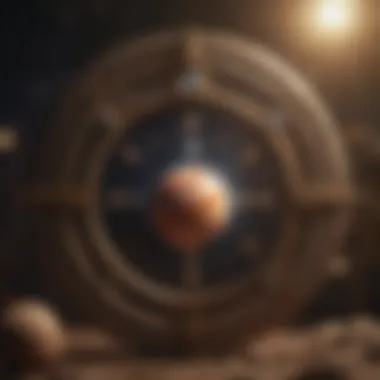Accurate Birth Chart Reading: A Comprehensive Guide


Intro
Reading a birth chart requires an understanding of various astrological components that influence personality and potential life paths. Accurate readings depend not only on precise information but also on a firm grasp of the underlying theories of astrology. This guide provides a comprehensive overview of the foundational concepts, the zodiac signs involved, and the significance of celestial events in astrological interpretation. The intention is to offer both new and experienced astrologers thorough insights into the intricate tapestry of birth chart analysis.
Astrological Concepts
Definition of Key Terms
Astrology is a field of study that examines the positions of celestial bodies to gain insights into human experience. Key terms include:
- Natal Chart: A map of where all the celestial bodies were located at the moment of one’s birth.
- Transit: The ongoing movement of planets through the zodiac, influencing current events in life.
- Aspects: The angles formed between planets in a chart, indicating how they interact.
Understanding these terms sets the groundwork for interpreting a birth chart in an astrological context.
Historical Background of Astrology
Astrology has roots in several ancient civilizations, including Babylonian, Egyptian, and Greek cultures. Each civilization contributed to the development of astrological literature and techniques. For example, the Babylonians laid the groundwork for zodiac signs, while Greek philosophers like Ptolemy synthesized various schools of thought into the foundational texts that many modern astrologers use today. The historical context enriches the practice, showcasing how astrology evolves with societal beliefs and scientific advances.
Overview of Different Astrology Branches
Astrology encompasses numerous branches, each offering distinct perspectives and methodologies:
- Natal Astrology: Focuses on the individual's birth chart and personality.
- Horary Astrology: Answers specific questions based on the time the question was asked.
- Mundane Astrology: Studies world events and their connections to astrological occurrences.
- Electional Astrology: Aids in selecting the best times for undertaking significant activities.
Each branch serves a unique purpose, illuminating various facets of life and the cosmos.
Zodiac Signs Exploration
In-Depth Analysis of Each Sign
The zodiac is divided into twelve signs, each governed by specific planetary rulers and elements. The qualities assigned to each sign shape identities and interactions with the world. The signs include Aries, Taurus, Gemini, and so forth. Analyzing each sign unveils their characteristics and behavioral tendencies, which are essential for understanding a birth chart fully.
Personality Traits and Characteristics
Each zodiac sign possesses a set of defining traits:
- Aries: Assertive, ambitious, and energetic.
- Taurus: Reliable, patient, and practical.
- Gemini: Adaptable, communicative, and curious.
- Cancer: Nurturing, protective, and intuitive.
These traits manifest differently depending on the individual's chart, including aspects and house placements.
Historical and Mythological Connections
Zodiac signs are often intertwined with mythology. For instance, Aries is associated with the ram from Greek mythology, symbolizing courage. Understanding these connections can deepen one’s interpretation of how signs influence an individual’s life and experiences.
Celestial Events
Major Cosmic Phenomena
Celestial events such as eclipses, retrogrades, and conjunctions play significant roles in astrological readings. These events can trigger changes in individual lives, prompting reflection or action.
Impact of Celestial Events on Astrology
Astrologers often track these events to predict shifts in collective energies and personal experiences. For example, Mercury retrograde is considered a time for reevaluating communication and travel. Understanding these patterns provides clarity when interpreting a birth chart.
Rituals and Practices During Celestial Events
Astrologers often recommend specific rituals during significant celestial events to harness their energy. These can include:
- Meditation: To gain insight and clarity.
- Journaling: To document thoughts and feelings.
- Cleansing Amulets: To prepare for new beginnings or changes.
These practices can enhance one's connection to astrological influences and aid in personal development.
Astrology is more than a tool for prediction; it is a pathway to understanding oneself and one’s place in the universe.


By exploring accurate birth chart reading, one can unlock profound insights into personality, potential, and challenges, empowering both the practitioner and the seekers of wisdom.
Preamble to Birth Chart Reading
Birth chart reading stands as a vital part of astrology. Understanding one's birth chart is akin to unlocking a deeper sense of self. This knowledge opens corridors to personal growth, guiding individuals in navigating life’s complexities. A well-interpreted birth chart offers insights into personality, strengths, weaknesses, and potential paths one might traverse. Consequently, the skill of chart reading is essential not only for astrologers but for anyone seeking to gain clarity in their personal journey.
Understanding Birth Charts
A birth chart, also known as a natal chart, is a snapshot of the sky at the time of one's birth. It is uniquely tailored to each individual, capturing the positions of the Sun, Moon, planets, and other celestial bodies. This cosmic map serves as a foundation for interpreting various aspects of life, from emotional dynamics to career choices. Each component of the chart holds significance. For instance, the Sun sign often signifies one's core identity, while the Moon sign reflects emotional responses.
Key elements of a birth chart include:
- Zodiac Signs: These are the twelve distinct signs that define personality traits.
- Houses: Each house corresponds to different life areas, such as relationships, career, and home.
- Planets: The planets influence the characteristics of the signs and houses they inhabit.
- Aspects: These are the angles formed between different planets, affecting their interactions and overall influences on the individual.
The synthesis of these components allows for a comprehensive understanding of an individual’s potential.
The Role of Astrology in Personal Insights
Astrology serves as a powerful tool for self-discovery. It guides individuals in understanding their emotional triggers and behavioral patterns. By analyzing the birth chart, one can identify inherent strengths and challenges. This awareness can lead to informed decisions, be it in personal relationships, career paths, or mental well-being.
Moreover, astrology encourages introspection. When individuals reflect on their chart, they often confront fears and aspirations. Such reflections facilitate personal development. Those experimenting with astrology find increased clarity and direction. The alignment of celestial bodies at one’s birth connects deeply to their nature, and comprehending this connection is pivotal for growth.
The study of astrology is not merely about predicting the future. It’s a profound exploration of self, leading to transformative insights.
In summary, understanding birth charts is central to harnessing the power of astrology. The intricate details captured in a natal chart can illuminate many facets of life, paving the way for informed choices and personal evolution.
Importance of Accurate Data
Accurate data is the backbone of any reliable birth chart reading. In astrology, each piece of information serves as a vital puzzle piece that helps in deciphering the overall picture. When analyzing a birth chart, it is imperative to obtain precise details about birth time and location. Without these elements, interpretations can sway significantly, leading to misunderstandings about a person’s astrological influences.
The Significance of Birth Time
Birth time plays a critical role in determining the rising sign or ascendant, which is the zodiac sign that was ascending on the eastern horizon at the precise moment of birth. The ascendant is essential because it influences a person’s outward appearance and first impressions. A miscalculation of just a few minutes can alter the entire chart. This can misrepresent a person’s core characteristics, and lead to incorrect interpretations. Thus, ensuring accuracy in recording the exact birth time is crucial for anyone seeking meaningful insights through astrology.
Moreover, the placement of planets in astrological houses is also contingent upon the exact birth time. Each house represents different areas of life, from career to relationships. If the time is wrong, the planets may fall into incorrect houses, skewing the analysis of relevant life themes. The importance of a precise birth time cannot be overstated. It is foundational for effective chart reading.
Location and Its Impact on Chart Accuracy
The geographical location where one is born significantly influences astrological considerations. Each location has unique coordinates affecting planetary positions and calculations. When interpreting a birth chart, even minor discrepancies in the location can yield drastically different results. Latitude and longitude details are essential for calculating the angles in the chart, such as the Midheaven and the Imum Coeli.
Additionally, the local time zone must be factored into astrological readings. Time zone adjustments ensure that the universal time is accurately converted to regional time. This is critical for establishing the correct context for the planetary placements.
In summary, the significance of precise data in astrology cannot be overlooked. With accurate birth time and location, practitioners can interpret birth charts with confidence, yielding insights that can profoundly affect personal understanding and growth. Everything from daily horoscopes to long-term life patterns can hinge on the accuracy of these foundational elements.
Key Components of a Birth Chart
Understanding the key components of a birth chart is crucial for anyone looking to delve into astrology. These elements form the foundation of the reading and help in interpreting the nuances of individual personalities and life experiences. Recognizing how these components interact offers insights that extend well beyond mere descriptions of character traits. This section will cover the zodiac signs, astrological houses, planets, and aspects. Each of these plays a distinct role, influencing various aspects of life.
Zodiac Signs and Their Implications
Zodiac signs are perhaps the most recognized element in astrology. Each sign is associated with distinct traits, characteristics, and tendencies. There are twelve zodiac signs, each corresponding to a specific period of the year. The significance of zodiac signs lies in their influence on personality traits. For instance, a person born under Aries might exhibit traits associated with courage and assertiveness, while someone born under Cancer may showcase a stronger inclination towards empathy and nurturing.
Understanding a person’s sun sign can be a starting point in interpreting their overall personality. However, it is essential to consider the full spectrum, which includes the moon sign and rising sign, for a more holistic approach.
Astrological Houses Explained
Astrological houses add another layer to birth chart interpretation. There are twelve houses, each representing different areas of life, such as relationships, career, and creativity. The positioning of planets in these houses can indicate where an individual is likely to focus their energies.
For example, a strong concentration of planets in the seventh house may highlight the importance of partnerships in a person's life, showing a potential for deep connections and relationship dynamics. Identifying which houses are activated in one’s chart can guide individuals towards understanding their primary life themes.
Planets and Their Significance
Planets symbolize various energies and influences in astrology. Each planet governs different aspects of our lives and often displays traits that affect personality. The sun, for instance, represents the core self, while the moon governs emotions and instinctual behaviors.


Mercury signifies communication styles, and Venus deals with love and relationships. When planets are positioned in certain signs and houses, they activate particular traits that become part of the individual’s experiences. An important task for astrologers is to assess how these planets interact and where their influence lies.
Understanding Aspects in Astrology
Aspects are angles formed between planets in a birth chart. They reveal how planetary energies work together or against each other. These relationships can create tension or harmony. For example, a square indicates a challenging dynamic, while a trine suggests a smooth flow of energy.
When interpreting aspects, one can gain insights into internal conflicts or support structures within the chart. Understanding these nuances is vital for a well-rounded interpretation of the birth chart. Ultimately, diving into aspects allows astrologers to uncover layers of complexity in each individual's astrological makeup.
In summary, the components of a birth chart – zodiac signs, houses, planets, and aspects – are interrelated elements that weave together a rich tapestry of personal insights. Each piece informs the others, creating a holistic view of the individual’s astrological profile.
Techniques for Reading a Birth Chart
Understanding the various techniques for reading a birth chart is crucial in astrology. These techniques are not merely tools but are essential methods that uncover deeper personal insights and life patterns. They offer readers a structured approach to navigating the complexities of astrological symbols and their meanings. The primary goal is to provide clarity and coherence in chart interpretation, which can lead to significant personal revelations.
Step-by-Step Guide to Chart Interpretation
To read a birth chart accurately, it is vital to follow a systematic approach. This process helps in breaking down the chart into manageable components. The following steps can guide you:
- Gather Necessary Information: Start by collecting the individual's birth details, namely birth date, time, and location.
- Generate the Birth Chart: Use a reliable source such as Astrodienst or Astrolabe to create the chart based on the gathered information.
- Identify Key Components: Look for major elements such as the sun sign, moon sign, and ascendant. Note the positions of planets in various houses.
- Analyze Aspects: Examine how planets interact with each other through aspects. This gives additional layer of understanding regarding influences on personality.
- Synthesize the Information: Combine insights from all components to form a cohesive interpretation. Consider personal context if available.
Following these steps ensures a thorough chart reading, providing a solid framework for interpretation without overlooking critical details.
Identifying Major Themes in the Chart
The next phase in reading a birth chart is identifying the major themes. These themes emerge from the positions of planets and the aspects they form. Some important themes to consider include:
- Life Challenges: Look for indications of struggles or areas that may require additional effort. For instance, hard aspects between Saturn and personal planets often point to obstacles.
- Talents and Strengths: Positive aspects, like trines or sextiles, can suggest natural abilities. Recognizing these can boost self-awareness and confidence.
- Relationship Dynamics: Venus and Mars placements provide insights into relational styles and preferences. These patterns are crucial for understanding social interactions.
Recognizing these themes helps in addressing personal growth areas, enhancing self-awareness.
Using Software Tools for Analysis
Modern technology offers a variety of software tools that can enhance the birth chart reading experience. These tools provide features that facilitate a more precise interpretation. Consider the following benefits:
- Precision and Speed: Software like Solar Fire or AstroGold allows for quick calculations and eliminates manual errors.
- Graphical Representations: Visual aids help in understanding complex aspects and how they interconnect. It assists in retaining focus during interpretation.
- Integration of Transits: Many tools offer current transits that relate to the natal chart. This adds a dynamic dimension to your interpretation.
Utilizing these tools can save time and promote accuracy, making the process more efficient.
The combination of traditional techniques and modern technology creates a more comprehensive system for interpreting birth charts. By mastering these strategies, astrologers can significantly enhance their reading capabilities.
Common Misconceptions about Birth Charts
Understanding the common misconceptions regarding birth charts is fundamental for accurate readings in astrology. These misconceptions can lead to misunderstandings, diminishing the real value that personal astrology may offer. Addressing these myths helps demystify astrology and provides clarity to those interested in pursuing deeper insights about themselves and their life paths.
Debunking Myths Surrounding Astrology
A significant myth is that astrology is purely fate-based and lacks individual agency. Many people believe that their chart determines their future with no autonomy involved. In reality, a birth chart serves as a tool to understand potential inclinations and energies in one’s life. It highlights areas of strength and challenges but does not dictate outcomes. Thus, the role of free will in shaping one’s destiny is crucial, and outcomes depend heavily on personal choices and actions.
Another frequent misconception is that all people born under the same zodiac sign will exhibit identical personality traits. While sun signs offer insights into core characteristics, they are just one component of a comprehensive birth chart. Other factors, such as the positions of moon signs and rising signs, contribute significantly to individuality. Each chart is unique, reflecting personal characteristics and life experiences that are specific to the individual.
Focusing on Individual Interpretation
One must also recognize the significance of interpreting a birth chart personally. Many often rely on generic horoscopes or readings that do not account for individual nuances. Birth charts reveal layers of personality traits, motivations, and situational influences that require personal reflection. It is essential to engage with your chart rather than passively absorb information. Each interpretation should involve thoughtful consideration of how the astrological elements resonate with your life experiences.
Astrology is a vast field, and differing methods of analysis exist, which can lead to varying interpretations. Therefore, pursuing deeper knowledge through study and practice is beneficial. Engaging in discussions with experienced astrologers or participating in astrology communities can provide insights and foster personal development.
"Astrology does not predict. Instead, it enhances understanding and fosters growth through self-awareness."
Practical Applications of Birth Chart Readings
Understanding the practical applications of birth chart readings serves as a bridge between astrological theory and real-life implementation. This section emphasizes how accurate readings can translate to tangible benefits in personal growth and interpersonal relationships. The use of astrological insights can shape one’s approach to various situations and choices, enhancing the overall understanding of self and others.
Personal Development Through Astrology


Personal development is one of the most profound applications of astrology. Many individuals seek insights into their character, strengths, and weaknesses through their birth charts. By interpreting key elements like sun signs, moon signs, and rising signs, one can uncover motivations and personal tendencies.
Through this practice, individuals can:
- Identify Areas for Improvement: Birth charts provide a roadmap for self-discovery. Knowing one's challenges can inspire growth and resilience.
- Harness Strengths Effectively: Understanding personal strengths allows for leveraging these traits in career or relational contexts.
- Set Realistic Goals: By being aware of the cosmic influences at play, individuals can set goals that align with their natural inclinations.
Astrology does not dictate fate; rather, it allows for informed decision-making. People often report that using their birth chart for personal development leads to greater clarity and peace of mind in various aspects of life.
Relationship Compatibility Insights
Astrology also plays a significant role in understanding relationship compatibility. By comparing birth charts, individuals gain insights into their interactions with others. This application helps in navigating personal relationships more effectively.
Certain combinations in zodiac placements can reveal natural affinities or potential challenges between partners.
Key considerations involve:
- Identifying Core Values: Birth charts highlight essential values and preferences, which play a critical role in compatibility.
- Understanding Emotional Dynamics: Analyzing moon signs can reveal emotional responses and needs of each person.
- Highlighting Areas of Conflict: By examining aspects in both charts, individuals can anticipate challenges and address them proactively.
Astrological compatibility does not necessarily dictate relationship success; rather, it provides layers of understanding. It promotes a deeper appreciation of one another and encourages communication about needs and expectations.
Resources for Further Learning
Understanding birth charts can deepen one’s knowledge of astrology. Yet, it is not just about reading the chart itself; it also requires continuous learning and exploration. Resources for further learning are crucial because they provide diverse perspectives and detailed insights into astrology. These resources can enhance both practical skills and theoretical knowledge. They encourage personal growth, helping individuals to refine their approach to interpreting birth charts. Moreover, these resources address various learning styles, ensuring that there is something for everyone.
Books and Guides on Astrology
Books and guides serve as foundational texts for aspiring astrologers and those keen to learn more about birth chart interpretations. A selection of recommended books includes:
- The Only Astrology Book You’ll Ever Need by Joanna Martine Woolfolk This comprehensive guide is suitable for beginners and offers a solid introduction to astrology principles.
- Astrology for the Soul by Jan Spiller This book focuses on the lunar nodes, presenting a unique viewpoint on life lessons and personal growth.
- Parker’s Astrology: The Definitive Guide by Julia and Derek Parker It covers everything from basic concepts to intricate details of chart reading.
Having a good set of books helps in deepening the understanding of astrological principles and techniques. It also presents real-world examples, which can be beneficial.
Online Tools and Calculators
The digital age has brought many advancements, making astrology accessible through numerous online tools and calculators. These resources are extremely helpful for generating quick and accurate birth charts. Some notable options are:
- AstroSeek This website provides free birth chart calculations along with a wide range of astrological predictions.
- Cafe Astrology Known for its user-friendly interface, it offers tools for personalized astrological readings along with detailed articles.
- Astro.com This platform is highly regarded for its accuracy and depth, offering advanced calculation options for experienced astrologers.
These tools can save time and enhance the accuracy of readings. They offer options to customize charts based on different parameters and various house systems.
Astrology Courses and Workshops
Courses and workshops represent a structured way to learn astrology. They allow for direct interaction with experienced astrologers who can guide learners through intricate concepts. Some options to consider include:
- The Astrology Podcast Offers workshops and lectures that delve into specific aspects of astrology in depth.
- Astrology University This platform provides a range of courses, from basic to advanced levels, covering different techniques and styles.
- Online community classes on platforms like Skillshare and Udemy These often allow learners to study at their own pace while engaging with a broader community.
These courses and workshops can foster a sense of community and support, which is invaluable for anyone committed to deepening their astrological knowledge. A structured learning environment can motivate continuous exploration and growth.
Continuous education in astrology cultivates a comprehensive understanding of both theoretical concepts and practical applications. Embracing various learning resources ensures a well-rounded perspective on birth chart reading.
Culmination
The conclusion of this article serves as an essential summary of the key insights into accurate birth chart reading. It encapsulates the diverse elements discussed throughout the guide while emphasizing how these components interact to provide a clearer understanding of oneself.
Recap of Key Points
In this article, we explored various facets of birth chart reading, including:
- The importance of precise data, such as birth time and location, which are crucial for accurate astrological interpretations.
- The core components of a birth chart, notably the zodiac signs, houses, planets, and aspects, which offer a holistic view of an individual’s personality.
- Practical techniques for reading and interpreting birth charts that can enhance personal development and relationship insights.
- Resources that can aid individuals in furthering their study and refining their interpretation skills in astrology.
These key points create a framework for understanding how astrological elements work together, allowing one to gain valuable personal insights.
Encouragement for Ongoing Exploration
Astrology is not a static field; it evolves with continued learning and practice. The exploration into birth chart reading opens avenues for deeper knowledge and awareness. Each chart is unique and tells a different story. As you delve further into your own birth chart or those of others, consider:
- Engaging with books that offer different perspectives or advanced techniques in astrology can further refine your skills.
- Utilizing online tools and attending workshops can provide more interactive learning experiences.
- Joining communities, like those found on platforms such as Reddit or Facebook, allows for shared insights and discussions.
By maintaining an open mind and a willingness to learn, you can unlock more profound wisdom not only about yourself but also about the intricate relationships that bind us all together through the cosmos.**







